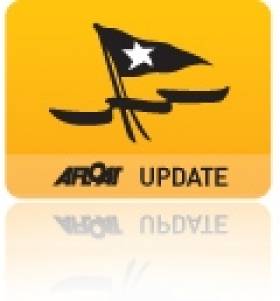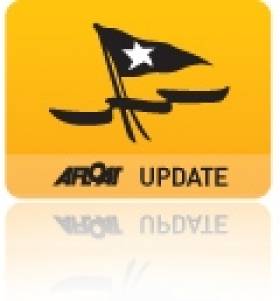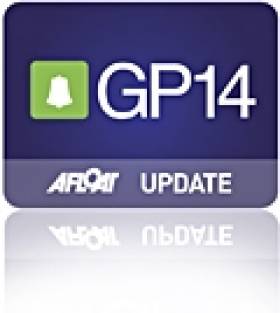Displaying items by tag: Skerries SC
Mermaid Championship Success for National Yacht Club's 'Tiller Girl'
#mermaid – The National Yacht Club's Jonathan O'Rourke with Carol Cronin and Alan O'Rourke in Mermaid No. 77 Tiller Girl have sailed to victory at the 2012 Mermaid National Championships in Skerries Sailing Club at the weekend. Last week's 40 boat regatta was sailed in a varitey of conditions and marked a special 80th anniversary for the clinker dinghy class. Full results available below as a pdf for download.
Of the six races O'Rourke and crew had four wins, a ninth and an eleventh place. The Dun Laoghaire trio also won a haul of class cups to boot inlcuding the Master's Trophy for helms older than a certain age! Celia No.5 Trophy for boats older than 40 years, the North Bull Cup for winning Race 3, Doreen Cup for Race 4, Rush Cup for Race 5 and Bailey Cup for Race 6.
Runner up was Skerries sailing Club's Mark Boylan with Niall Collins and Andrew Sexton sailing No. 177. Of the six races Mark and crew had three seconds, a third and two sixths.
O'Rourke's club mate Roger Bannon sailing with Kate Grimes and Robert Bannon in No. 102 Endeavour. Of the six races Bannon and crew had a win, a second, a third, a fourth, an eleventh and a disqualification.
Local Trio Lead 80th Anniversary Mermaid Nationals off Skerries
#mermaid – One of the biggest Irish one design dinghy fleets of the 2012 season has gathered in North Dublin this week to celebrate an important birthday both for the class and Irish sailing. The 80th Anniversary Mermaid Championships in Skerries has attracted 41 entries who have enjoyed very close racing in light winds, strong tides and coped with yesterday's poor visibility with dense fog rolling in from the Irish Sea. Full results to date are available for download below.
Most of the usual names are to be seen at the top of the leader board but a number of new young helms are making their impression, not the least being the consistent performance from 20 year old Mark Boylan and his young crew from Skerries sailing a boat built by his grandfather no177 "This Is It"
After 4 races Mark Boylan leads from a group of former winners including Paddy Dillon in Wild Wind no131 and Roger Bannon in Endeavour no102.
Jonathan O Rourke in Tiller Girl no 77 has recorded 2 back to back emphatic wins but a slow start in earlier races currently holds him in 5th place just behind another multiple championship winner Jim Carthy from Rush in the famous Vee no 123.
The top 3 boats are within 3 points of each other and the race on Thursday when the discard clicks in will undoubtedly have a dramatic impact on the outcome with Tiller Girl hoping to claw back ground lost earlier in the week and go into Friday with a real prospect of success in conditions she normally dominates.
Olympic Effort Did Not Shift McCarthy and Davis
Eagle eyed observers will most definitely have spotted Beijing Double Olympic race winner Gerald 'Gerbil' Owens is racing GP14s these days; a newsworthy point that escaped an earlier report about last weekend's event. Here's a more detailed Leinsters 2010 Event Report by Ruan O'Tiarnaigh that describes how Shane McCarthy and Andy 'Taxi' Davis fought off a determined effort from Owens and Melanie Morris to take the Championships at Skerries SC.
It was a tricky weekend in Skerries. Not as tricky as in Crosshaven where Niall Henry and James Conlon were representing the GP14 class at the All Ireland Sailing Championships, or the event formerly known as the Helmsman's, which saw no racing in the finals on Sunday, and the organisers looking for another date to bring those who qualified from the preliminary rounds back to Cork to decide on a winner. Niall and James will be there, and our best wishes go with them.
However despite the vagaries of the weather, PRO Liam Dineen made a fine job of providing races to the 40 strong GP14 fleet.
Racing Saturday began in near perfect conditions, as the fleet enjoyed 12-15kts of breeze from the North. A number of early casualties, which included Shane McCarthy and the dynamic pairing of Paddy O'Connor and Tanya McHale from Sligo, were caught for speeding at the start, and were rewarded with OCS's at the finish. Shining lights in Race 1 were the McGuinness Brothers, John and Donal, whose first place marked the highlight of their day as subsequent races saw a gradual and determined fall down the rankings.
Second in race 1 was the master boat builder Alistair Duffin and crew Paul Whitcombe from Newtownards and East Down respectively, who sailed a great race in the shifty conditions. Third place went to the team of Ruan O'Tiarnaigh and Libby Tierney, Ruan making a guest appearance in Simon Cully's stead.
The wind speed was falling, and with that brought an increased randomness in its direction. That coupled with the strong Skerries tide made for exciting, if somewhat mentally taxing racing conditions.
Race 2 started with a significant backing of the breeze. Out of the melee were the usual suspects, with Olympic 470 sailing legend, Gerry 'Gerbil' Owens and Melanie Morris establishing an early lead. Despite best efforts of the fleet, the experience and skill of the team were sufficient to maintain and even stretch a lead to the finish. Alistair Duffin and Paul Whitcombe again took the runners up spot and Shane McCarthy and Andy Davis finished good third.
Race 3, and the fleet were somewhat thrown after the start with a severe veer, but riding high in a new Duffin boat was veteran GP14 sailor Raymond Morrison with Brian Morrison streaking into the lead at the first mark, benefiting from the 30degree rightie. Raymond and Brian sailed a marvellous race to finish third, behind Gerbil Owen who took the gun, and Shane McCarthy in second.
In anticipation of little breeze on Sunday, the PRO raced a 4th race on Saturday. This proved to be as tricky a race as any this commentator has seen. With the Skerries tide in full swirl and the breeze in non-committal humour, the fleet once again headed towards the north with trepidation. The race was led at the first mark by newly elected president Richard Street and Dan Crilly from Blessington. This race was nip and tuck between the Blessington duo and the teams of McCarthy & Davis, and Clive and Philip Goodwin. Despite having lost the lead 'el Presidente' regained it to cross the line first, alas this was not greeted with the sweet sound of a hooter, as the duck egg coloured boat had started prematurely, and so the victory went to McCarthy & Davis with Goodwins in second and O'Tiarnaigh & Tierney taking third much to their relief, having been up and down the placings throughout the race.
Overnight saw Shane McCarthy and Andy Davis lead with 6 points, Owens and Morris on 7, the Goodwin's on 11, and tied for 4th on 13 points the teams of Duffin & Whitecombe and O'Tiarnaigh & Tierney.
Very notable on this day was the team of Diana Kissane and Niamh McCormack who were consistently at the business end of the proceedings and chalked up a 7, 5, 4 after their inaugural warm up in race 1, which left them lying in 6th overnight.
The forecast for Sunday was for dying breeze, and the weather did not disappoint in that regard. Another tricky day with great variations of strength and direction lay ahead.
Team Goodwin established an early lead in race 5 which they maintained through to the finish, with McCarthy and Davis in Second. The McGuinness brothers finished third having made a recovery that Lazerus would have been proud of, given that they found themselves in what is commonly known as 'a challenging position' on lap 1. A tack hard right on the third beat propelled them back into contention courtesy of a line of stronger breeze. Once again the pairings of Owens & Morris and O'Tiarnaigh & Tierney were in the shake-up finishing 5th and 4th respectively, with only inches separating them at the line.
Into the final race the pressure was on team of McCarthy & Davis who were carrying an OCS from Race 1. However it was to be their day as they led at the first mark, and despite the persistent and sustained attentions of Owens & Morris, the 'Team Speed Sails' duo maintained a slight lead to take the gun and also the title.
Second in the final race and also second overall were Owens and Morris, followed closely by the Goodwin team and O'Tiarnaigh & Tierney in 4th with the McGuinnesses in 5th.
The silver fleet was comprehensively won by Diane Kissane and Niamh McCormack from Howth YC who finished 8th overall with Doire Shiels and Sean Collins second and Cathal Sheridan and David Cooke only a point behind on the overall classification, both boats from host club Skerries SC.
The bronze fleet was a close run event with only 5 points separating the top three boats. The final result saw Gary Rock and Gosia Oleskow from Mullingar SC first, Jonathan Cully and Oisin McCelland, BYC, second, and Noel Clarke and Paul Kelly from Skerries SC third.
The evenness and versatility of the GP14 was commented upon by Gerbil Owens. 'It is amazing that ages from 15 to 65, and from light to heavy weight teams are all accommodated so well by the GP, and the racing is fantastic.































































